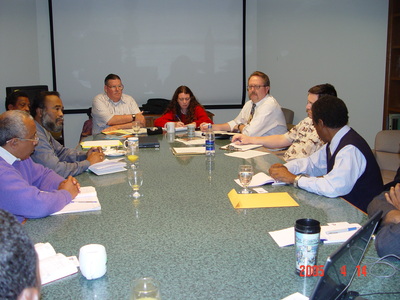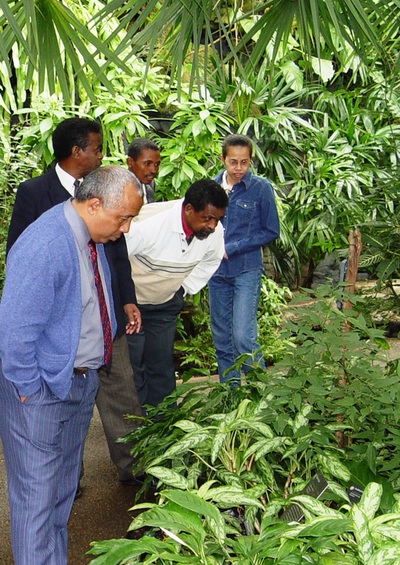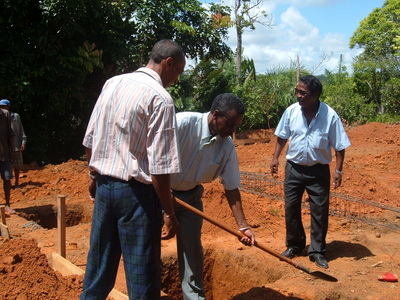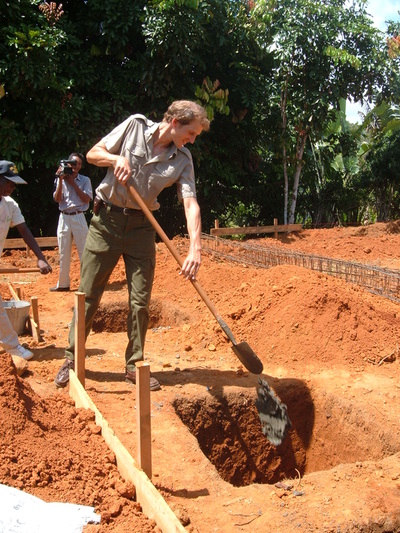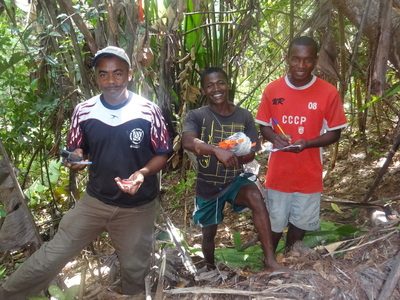The Ivoloina Conservation Training Center
Madagascar's National Environmental Action Plan, Phase 3 (NEAP 2003-2008) placed a significant focus on decentralizing natural resource management decisions. The Ivoloina Conservation and Training Center (ICTC) was built to increase Toamasina's institutional capacity to train the conservation biologists and natural resource managers of the future. The Center includes a space for meetings and workshops, an equipped laboratory, a computer room/library, dormitory and dining facilities.
In late 2003 Andrea Katz and Charlie Welch, MFG Program Managers, held a series of meetings with the President of the Province of Toamasina, University of Toamasina faculty, Madagascar National Parks and Department of Water and Forest officials, public school educators, and business leaders to hear their thoughts on how the MFG could best serve the community over the next five to ten years. The predominant theme that emerged from these meetings was Toamasina's limited capacity to train natural resource managers. At the national level, Madagascar recognized the importance of protecting the environment as evidenced by being the first African country to have an environmental strategy. Madagascar's National Environmental Action Plan, approved by the National Assembly in 1990, was a 15 year plan divided into three phases. It included development and governance objectives in addition to those aimed at improving management of the country’s natural resources, reversing environmental degradation and transferring some natural resource management responsibilities over to local communities. It was an ambitious plan that required an educated workforce to succeed. In 2003 it was already quite clear that Madagascar did not have sufficiently skilled people to manage its protected areas nor were there enough people who could train villagers in more sustainable land use practices. The concern over how to address the issue had risen in priority following President Ravalomanana’s speech at the 2003 Durban World Parks Conference where he pledged to triple the size of Madagascar’s protected areas. The MFG could best serve the community by helping to increase the number and quality of training opportunities available to students and practitioners.
Andrea and Charlie followed up the meetings by presenting a proposal for the construction of a training center at Parc Ivoloina to the MFG's Board which was approved. To gain a more thorough understanding of the programmatic needs, the MFG organized a meeting that brought together community leaders from Toamasina with colleagues from four universities, the Saint Louis Zoo and Missouri Botanical Garden for the objective of identifying potential collaborations to: (1) increase the availability of training opportunities for students and practitioners in the fields of conservation biology, natural resource management, sustainable land use and environmental education and (2) increase institutional capacity within Madagascar with a special focus on the Toamasina Region. The workshop facilitated discussions by first having the Malagasy delegation give presentations on the status, including gaps and needs, of training opportunities in Toamasina. Presentations by the US participants focused on identifying potential educational opportunities available through their respective institutions.
“As in other developing countries, not only Madagascar, where 80% of people are rural, there are conflicts between poverty and biodiversity. Most rural people subsist on agriculture and in so doing put a very heavy toll on the environment. It is necessary to address this issue. We can't have poverty and biodiversity co-existing. If biodiversity will win, poverty must lose." Dr. Emile Tsizarina, 13 April 2005
Those simple but insightful words spoken by Dr.Tsizarina resonated with the assembled group. A strong connection developed between Dr. Gene Garrett, Director of the University of Missouri's Center for Agroforestry and Dr. Tsizarina who invited him to Toamasina to continue discussions. Dr. Garrett in turn invited Christof den Biggelaar,PhD, a colleague with tropical agroforestry experience, to accompany him. In September 2005 Drs. Garrett and den Biggelaar traveled to Madagascar where they met with Toamasina's provincial authorities, University of Toamasina's faculty and MFG staff to: (1) discuss the initiation of ecoagriculture education, training and research programs and identify target user groups, (2) advise how to best equip the Training Center and use the mixed habitats within Parc Ivoloina as a teaching and research field station, and (3) explore the application of an ecoagriculture approach to the matrix of farmed land surrounding Ivoloina and Betampona.
Site visits were arranged for Drs. Garrett and den Biggelaar to meet with Malagasy agroforestry research and extension professionals and observe their facilities, tour the University's Department of Natural Resources (GRENE) and travel to rural villages to observe farming practices and speak with villagers. Meetings with the extension agents revealed significant gaps in essential interdisciplinary knowledge and skills that are required to implement effective and appropriate agroforestry and ecoagriculture programs. Viewing the University of Toamasina's facilities underscored the challenges facing instructors who, with minimal access to textbooks and lacking laboratories, try to train the next generation of Madagascar's natural resource managers. Without labs, journals, and other reference materials, undergraduate and graduate students are deprived of basic resources indispensable to developing creative and independent thinking skills that enable them to synthesize and apply their acquired knowledge to address Madagascar's environmental problems. Such gaps in Madagascar's formal education system can reverberate through students' professional careers as park managers, researchers, teachers, practitioners and leaders of the country's governing ministries and conservation NGOs.
When construction of the center began in late 2005 it was marked by speeches from Dr. Tsizarina, Program Manager Karen Freeman and other community leaders. The ICTC was built in stages; the first was the meeting room, laboratory and computer room/library. Funding was provided by the Saint Louis Zoo's WildCare Institute and the city of Toamasina, while equipment for the laboratory was funded through a grant from the American Zoo and Aquarium Association.
Construction was completed in June 2006 but the Center was officially inaugurated on July 10th in a ceremony attended by MFG Board members and advisors, city officials, university and business leaders, over 300 villagers and Minister of the Environment.
The feature that adds the greatest value to the ICTC is its location in Parc Ivoloina. A common complaint expressed by graduates of Madagascar's universities was the lack of opportunities to practice theoretical classroom work through hands-on field experience. Parc Ivoloina's mixed landscapes, diversity of native fauna, ecoagriculture research plots and forest restoration activities make it an ideal field site for students to gain the practical experience in multiple disciplines they will need in their chosen profession.










